Winter brings chilly weather, cozy nights by the fire, and unfortunately, an increase in pest activity. As temperatures drop, many pests, including rodents, spiders, and insects, seek the warmth and shelter of our homes. The key to keeping these unwanted guests out is effective winterproofing your home. With the right strategies, you can safeguard your space from infestations while also enhancing energy efficiency.
Why Winterproofing Matters
Pests such as mice, rats, cockroaches, and spiders are resourceful. They can squeeze through surprisingly small gaps, making homes with poor seals prime targets during the winter months. Effective winterproofing not only prevents pest invasions but also helps to lower heating costs by reducing drafts and heat loss.
Let’s break down how to seal your home against pests this winter.
1.Inspect Your Home’s Exterior
The first step in winterproofing your home is identifying potential entry points. Common areas where pests enter include:
- Doors and Windows: Check for gaps around frames, loose weatherstripping, or damaged screens.
- Foundation Cracks: Small cracks in the foundation can serve as a highway for insects and rodents.
- Roof and Eaves: Look for damaged shingles, loose vents, or holes that could provide access to the attic.
- Pipes and Wires: Ensure areas where utility lines and pipes enter your home are sealed tightly.
Tip: Walk around your home with a flashlight and a notepad, noting any gaps or cracks larger than 1/4 inch, as these are wide enough for pests to enter.
2.Seal Cracks and Gaps
Once you’ve identified entry points, the next step is to seal them. Use the appropriate materials for each area:
- Caulk for Small Cracks: Silicone-based caulk is ideal for sealing small gaps around windows, doors, and trim.
- Steel Wool for Larger Holes: Rodents can chew through many materials, but not steel wool. Fill larger gaps with steel wool, then seal with caulk for extra protection.
- Expandable Foam for Utility Areas: Expandable foam provides an airtight seal for gaps around pipes, vents, and utility wires.
Pro Tip: Pay attention to the weather. Sealants adhere best when applied in dry conditions above freezing temperatures.
3.Install or Upgrade Weatherstripping
Weatherstripping is a critical component of winterproofing your home. It provides a barrier against pests and cold drafts. Focus on these areas:
- Exterior Doors: Check the seals around your doors. Replace worn or damaged weatherstripping and add a door sweep if necessary.
- Windows: Inspect sliding and casement windows for worn seals and replace them with fresh weatherstripping.
- Garage Doors: Pests often enter through poorly sealed garage doors. Add a bottom seal to keep them out.
4.Protect Your Roof and Attic
The roof and attic are hotspots for pest activity during winter. Birds, squirrels, and rodents can nest here if given the opportunity. Steps to take include:
- Repair Roof Damage: Replace any missing shingles and repair loose flashing.
- Inspect Vents and Chimneys: Cover vents and chimneys with a fine mesh screen to prevent entry while maintaining airflow. You can also install bird spikes around them to deter birds from entering.
- Seal Gable Vents: Rodents often enter through gable vents. Ensure these are covered with durable screens.
5.Maintain a Clean Perimeter
The area around your home’s foundation can either deter or attract pests. To discourage pests from approaching your home:
- Trim Vegetation: Keep bushes, trees, and shrubs trimmed back at least two feet from your house.
- Clear Debris: Remove leaves, woodpiles, and other debris where pests might nest or hide.
- Use Gravel Mulch: Replace organic mulch with gravel around your foundation to reduce hiding spots for pests.
6.Store Firewood Properly
Firewood piles can be a haven for insects and rodents. Follow these guidelines to minimize risk:
- Store firewood at least 20 feet away from your home.
- Elevate woodpiles off the ground to reduce nesting opportunities.
- Inspect firewood before bringing it indoors to ensure no pests hitch a ride.
7.Keep Your Home Clean and Tidy
A cluttered home is more inviting to pests. Declutter and deep clean your home before winter sets in. Focus on areas like:
- Kitchen: Store food in airtight containers and clean crumbs from countertops, cabinets, and floors.
- Basement and Attic: These areas are often neglected but can harbor pests. Organize items and inspect for signs of infestation.
- Garbage Storage: Use lidded garbage cans and take out the trash regularly.
8.Monitor and Maintain Moisture Levels
Many pests, such as cockroaches and silverfish, are drawn to moisture. Addressing humidity issues in your home can reduce their appeal:
- Fix Leaks: Repair dripping faucets, leaking pipes, and any other water sources.
- Use a Dehumidifier: In damp areas like basements, a dehumidifier can make the environment less hospitable to pests.
- Inspect Gutters: Clear gutters and downspouts to prevent water accumulation near your foundation.
9.Invest in Professional Help
If you’re unsure about how to properly winterproof your home, a pest control professional can help. They can:
- Identify hard-to-spot entry points.
- Apply specialized treatments for long-term pest prevention.
- Provide advice tailored to your home’s specific needs.
Hiring a professional can be especially beneficial for homes in areas with heavy pest activity.
10.Regularly Check Your Home
Winterproofing isn’t a one-and-done task. Regular inspections throughout the season are essential. Look for signs of pest activity, such as:
- Droppings or gnaw marks.
- Strange noises in the walls or attic.
- Nesting materials or live insects.
Address issues promptly to prevent a small problem from becoming a larger infestation.
Additional Benefits of Winterproofing
In addition to keeping pests at bay, winterproofing your home has several other advantages:
- Energy Efficiency: Sealing gaps and cracks reduces drafts, helping your heating system work more efficiently.
- Improved Air Quality: Keeping out pests also minimizes allergens like droppings and dander.
- Cost Savings: By reducing pest infestations and energy waste, you’ll save money in the long run.
Conclusion
Winterproofing your home against pests is an investment in your comfort, health, and property. By taking proactive steps to seal entry points, maintain cleanliness, and monitor your home throughout the season, you can enjoy a pest-free winter.
Don’t wait until pests have moved in—start your winterproofing efforts today. For homeowners seeking peace of mind, consider consulting with a pest control professional to ensure your home is fully protected.
Stay warm, stay pest-free, and enjoy the cozy winter season knowing your home is secure.












